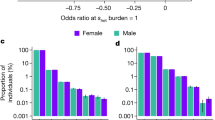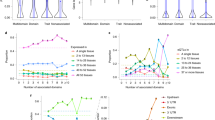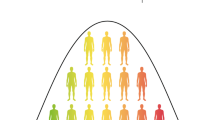Abstract
Less than 2% of the 80–90% heritability of major psychiatric disease, for example, schizophrenia and manic-depressive illness is attributable to genes identified by linkage and association. Where is the missing heritability? The recently described PRDM9 gene imposes epigenetic stability on the XY body in male meiosis including Sapiens-specific variation relating to a gene pair (Protocadherin11XY) created by X to Y duplication at 6MYA. Thus sexually dimorphic variation that distinguishes the species may be transmitted between generations in epigenetic form that evades detection by linkage and association.
This is a preview of subscription content, access via your institution
Access options
Subscribe to this journal
Receive 12 print issues and online access
$259.00 per year
only $21.58 per issue
Buy this article
- Purchase on Springer Link
- Instant access to full article PDF
Prices may be subject to local taxes which are calculated during checkout
Similar content being viewed by others
References
Gusella JF, Wexler NS, Conneally PM, Naylor SL, Anderson MA, Tanzi RE et al. A polymorphic DNA marker genetically linked to Huntington's disease. Nature 1983; 306: 234–238.
Hsiao K, Baker HF, Crow TJ, Poulter M, Owen F, Terwilliger JD et al. Linkage of a prion protein missense variant to Gerstmann-Straussler syndrome. Nature 1989; 338: 342–345.
Crow TJ . How and why genetic linkage has not solved the problem of psychosis: review and hypothesis. Am J Psychiatry 2007; 164: 13–21.
Sanders AR, Duan J, Levinson DF, Shi J, He D, Hou C et al. No significant association of 14 candidate genes with schizophrenia in a large European ancestry sample: implications for psychiatric genetics. Am J Psychiatry 2008; 165: 497–506.
Psychiatric GWAS Consortium Coordinating Committee. Genomewide association studies: history, rationale, and prospects for psychiatric disorders. Am J Psychiatry 2009; 166: 540–556.
The Wellcome Trust Case Control Consortium. Genome-wide association study of CNVs in 16 000 cases of eight common diseases and 3000 shared controls. Nature 2010; 464: 713–720.
Purcell SM, Wray NR, Stone JL, Visscher PM, O’onovan MC, Sullivan PF et al. Common polygenic variation contributes to risk of schizophrenia and bipolar disorder. Nature 2009; 460: 748–752.
Book JA . Schizophrenia as a gene mutation. Acta Genet Stat Med 1953; 4: 133–139.
Karlsson JL . Inheritance of Creative Intelligence. Nelson-Hall: Chicago, 1978.
Huxley TH . Evidence of Man's Place in Nature. Williams & Norgate: London, 1863.
Forsdyke DR . The Origin of Species Re-visited. McGill-Queen's University Press: Kingston & Montreal, 2001.
Romanes GJ . Darwin, and After Darwin. Post-Darwinian Questions: Isolation and Physiological Selection. Longmans, Green: London, 1897.
Bateson B . Heredity and variation in modern lights. (From Darwin and modern science). William Bateson, Naturalist. His Essays and Addresses Together with a Short Account of His Life. Cambridge University Press: London, 1928, pp 215–232.
Haldane JBS . Sex-ratio and unisexual sterility in hybrid animals. J Genet 1922; 12: 101–109.
Presgraves DC . Sex chromosomes and speciation in Drosophila. Trends Genet 2008; 24: 336–343.
Ohno S . Sex Chromosomes and Sex-Linked Genes. Springer-Verlag: Berlin, 1967.
Crow TJ . Sexual selection, timing and an X-Y homologous gene: did Homo sapiens speciate on the Y chromosome?. In Crow TJ (ed). The Speciation of Modern Homo Sapiens. Oxford University Press: Oxford, 2002, pp 195–216.
Myers S, Bowden R, Tumian A, Bontrop RE, Freeman C, MacFie TS et al. Drive against hotspot motifs in primates implicates the PRDM9 gene in meiotic recombination. Science 2010; 327: 876–879.
Turner JMA . Meiotic sex chromosome inactivation. Development 2007; 134: 1823–1831.
Williams NA, Close J, Giouzeli M, Crow TJ . Accelerated evolution of Protocadherin11X/Y: a candidate gene-pair for cerebral asymmetry and language. Am J Med Genet (Neuropsychiatric Genet) 2006; 141B: 623–633.
Broca P . Remarques sur la siége de la faculté du langue. Bull Soci Anat Paris (2nd Ser) 1861; 6: 330–357.
Author information
Authors and Affiliations
Corresponding author
Ethics declarations
Competing interests
The author declares no conflict of interest.
Rights and permissions
About this article
Cite this article
Crow, T. ‘The missing genes: what happened to the heritability of psychiatric disorders?’. Mol Psychiatry 16, 362–364 (2011). https://doi.org/10.1038/mp.2010.92
Received:
Accepted:
Published:
Issue Date:
DOI: https://doi.org/10.1038/mp.2010.92
Keywords
This article is cited by
-
Across the great divide: pluralism and the hunt for missing heritability
Synthese (2021)
-
Transgenerational epigenetic influences of paternal environmental exposures on brain function and predisposition to psychiatric disorders
Molecular Psychiatry (2019)
-
Genomic trade-offs: are autism and schizophrenia the steep price of the human brain?
Human Genetics (2018)
-
A model to investigate SNPs’ interaction in GWAS studies
Journal of Neural Transmission (2015)
-
Genome-wide study of association and interaction with maternal cytomegalovirus infection suggests new schizophrenia loci
Molecular Psychiatry (2014)



